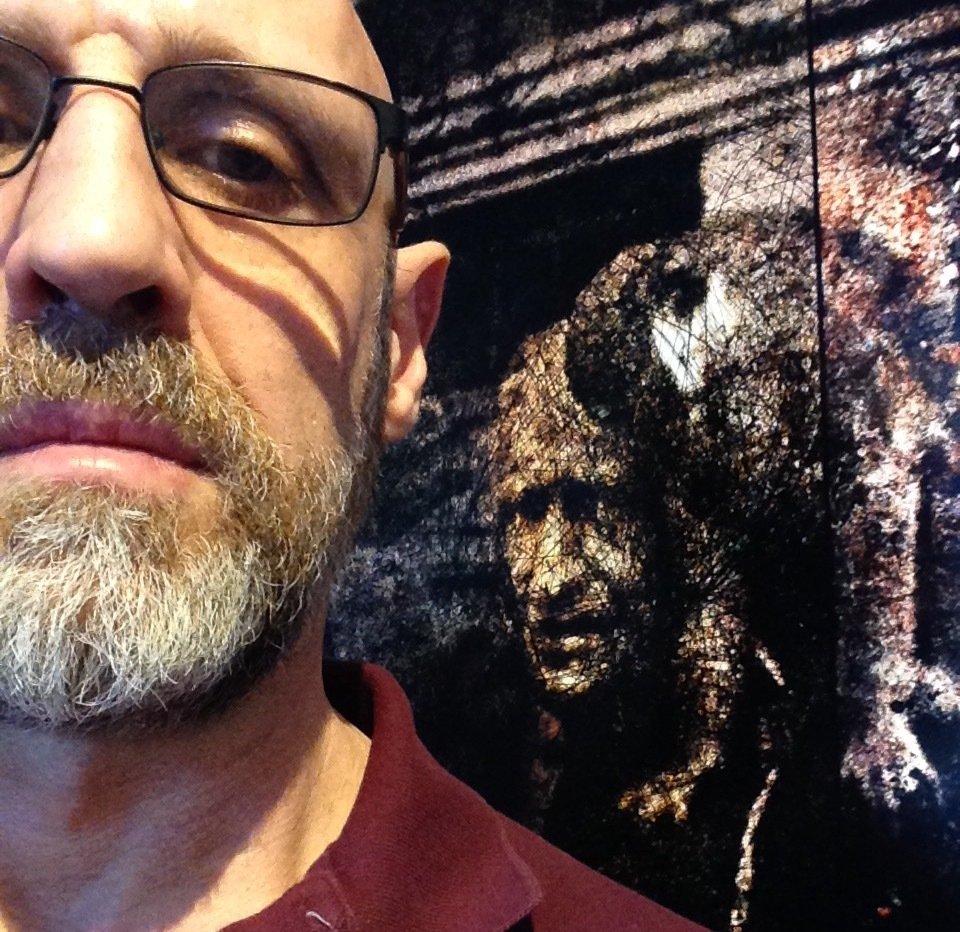 Frank Rodick in front of Parade in Petticoat Lane (detail), April, 2015. Courtesy of the artist
Frank Rodick in front of Parade in Petticoat Lane (detail), April, 2015. Courtesy of the artist
Interview with Frank Rodick (F.R) by Emese Krunák-Hajagos (E.K-H)
E.K-H: You are an internationally acclaimed Toronto artist with many exhibitions to your credit and numerous articles about your photographs. This one is your first solo show in the city. Why have there not been any shows of your work earlier. How did you and Articsok Gallery find each other?
F.R: Actually, it’s not my first solo show in Toronto, but it is the first in ten years. The simplest reason for that is I’ve been busy with exhibitions outside the country, mostly in the US and Latin America, also in Europe and elsewhere. I’ve generally shown where I’ve been invited. Articsók Gallery found me through LinkedIn and my website.
E.K-H: Your show Everything Will Be Forgotten is about the past, your mother and your child-self. Why did you decide to dedicate a whole exhibition to that theme?
F.R: It’s because that’s my most recent work and I’ve never shown it in Canada. I did this work – in particular the portraits of my mother – in response to my mother’s death in 2010. What compelled me most were her life, her death and our relationship. As for the self-portraits – and there are self-portraits of myself as both an adult and as a child – they followed, I suppose, because of this reflective frame of mind. The death of a parent – especially one’s last surviving parent – is a seminal event for most people and it gets you thinking, more and perhaps differently, about your own life. Fates cooperated because I found a lot of old photographs and documents in family archives.
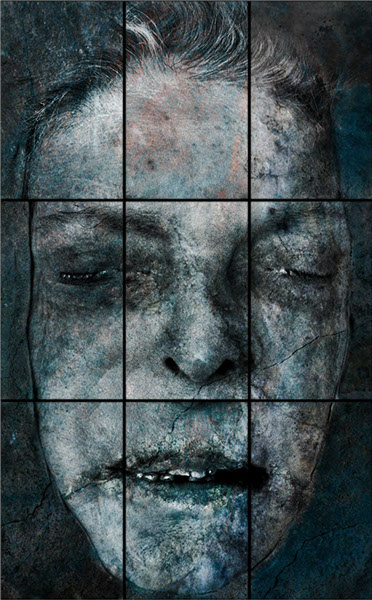 Frank Rodick, 97532, no. 1, 2011, archival pigment print,100 x 63.9 cm.
Frank Rodick, 97532, no. 1, 2011, archival pigment print,100 x 63.9 cm.
E.K-H: On Parade in Petticoat Lane your young mother seems to be walking down Memory Lane with a small wicker basket in her hand. She could be in any old European city but the blind musician hints at an American one. Why did you choose those elements for this photomontage?
F.R: This image is based on an old photograph taken by my father in 1952, I believe. My parents really were in London’s Petticoat Lane according to what’s written on the back of the photograph. It’s a great picture, the best photo my father – an amateur photographer – ever did. All the figures are in the original photograph: my mother, the woman behind her, the veteran with medals and the chained monkey on his shoulder, and the blind musician. It’s really brilliant on its own. What I did was transform the image, push and pull it into the shape I wanted it to have. So I injected formal elements like the colours (the original is black and white), the over- and underlaid textures. I scratched over the monkey. I exaggerated and de-emphasized things like facial features: eyes, the shapes of mouths. The little changes – that when you put them all together can mean a radical changing of the overall image – are a version of what R Crumb called cheating – little things you do to push the image in the direction you want.
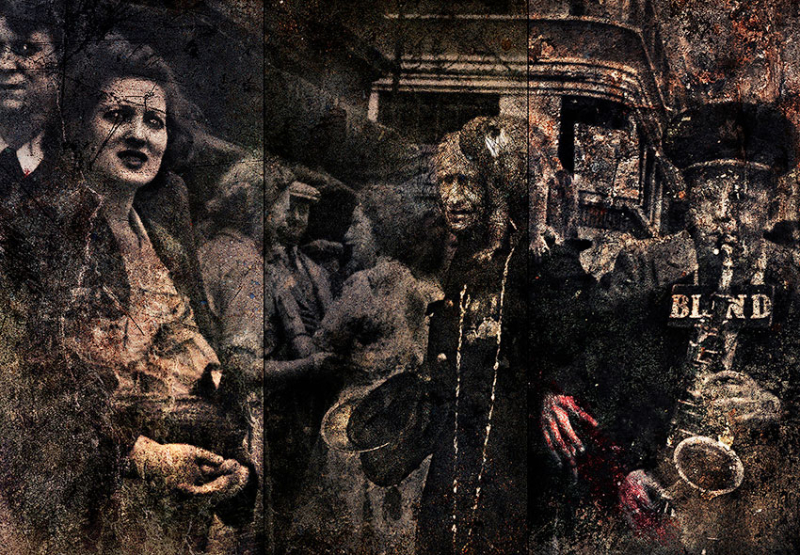 Frank Rodick, Parade in Petticoat Lane (my mother holds her basket), 2014, archival pigment print, 100 x 152 cm. Courtesy of the artist and Articsók Gallery
Frank Rodick, Parade in Petticoat Lane (my mother holds her basket), 2014, archival pigment print, 100 x 152 cm. Courtesy of the artist and Articsók Gallery
When I look at it I feel like the image is a fantastic harvest of humanity as well as part of my mother’s story. There are these tragic characters: the veteran, the blind trumpet player, and that sad chained monkey looking down. The monkey is my favourite; he slays me with his pathos. There’s the woman behind my mother who towers above her with this knowing, ominous look directly at the viewer. And there’s my mother, also looking into the camera, with what’s to me an almost mystified look, a deer in the headlights. For me, it speaks to her anxieties about life and her future – that the world would be too much for her, that its unyielding, violent reality would overtake and crush her. It’s like an apocalypse of the everyday, a sad and dark carnival.
E.K-H: All the images are touched up and aged. They look even older than their historical time would insist, almost daguerreotype like. Why?
F.R: My intention in manipulating the images isn’t necessarily to make them look more aged. What I’m trying to do is make the image represent something more real to me, not less. More real as an expression of something passed through my subjective self. I often quote Céline, who is maybe my favourite twentieth century writer. Céline said he wanted to create hallucinations that were more real than everyday life and carry the reader to a deeper and more compelling subjective and personal reality. I get that completely.
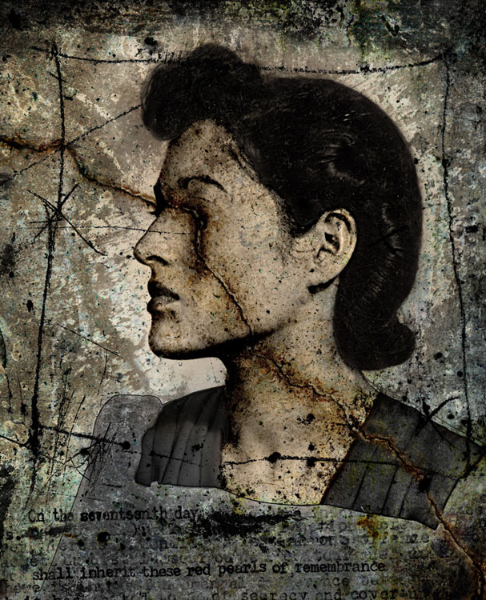 Frank Rodick, Portrait, Frances Rodick (red pearls), 2012, archival pigment print, 100 x 81 cm. Courtesy of the artist and Articsók Gallery
Frank Rodick, Portrait, Frances Rodick (red pearls), 2012, archival pigment print, 100 x 81 cm. Courtesy of the artist and Articsók Gallery
E.K-H: Your mother was truly beautiful but in many of her portraits her face is destroyed. It reminds me of the damage that sometimes resulted when the glass plate, photographers used, got dirt stuck on it or some acid ran on it. It looks like something similar happened to the photos of your mother’s face. The image appears cut or eroded by acids or smashed by some dirt and these attacks wiped off her identity (Portrait, Frances Rodick series). What did you intend to express with this method?
F.R: There are a number of things going on simultaneously here for me. What I do is just start trying a lot of things and seeing what they look like, and those things that appeal to me visually, well, I work with those some more.
 Frank Rodick, Portrait, Frances Rodick (stone cold), 2012, archival pigment print, 100 x 81 cm. Courtesy of the artist and Articsók Gallery
Frank Rodick, Portrait, Frances Rodick (stone cold), 2012, archival pigment print, 100 x 81 cm. Courtesy of the artist and Articsók Gallery
When I look at the obfuscations on my mother’s face I see different things. There’s the damage of Alzheimer’s disease, which is something my mother lived with longer than any human should: well over 15 years. That’s a disease that’s a personality destroyer. There’s the damage caused by not only her experiences but also the way I think she internalized some of those experiences, how she processed her hardships and also the hardships of others, in particular, the personal consequences of anti-Semitism, which, of course, found its ultimate expression in the Nazi extermination. There’s also the obfuscation caused by my own perceptions and memories, which “get in the way,” carry their own blockages and blind alleys, and prevent me from knowing her, just as they get in the way of anyone knowing anyone else. That obfuscation runs two ways – it runs from my own self to my mother, just as it ran from my mother out into the world. I mean, really, when it comes to knowing the world, knowing each other, knowing ourselves, we’re all far more blind than we are sighted. That’s the reality that I see. Another point about the markings over my mother’s face: I think they’re an expression of my anger, which, sadly, is a tendency I share with my mother, although our respective angers expressed themselves differently and in different directions.
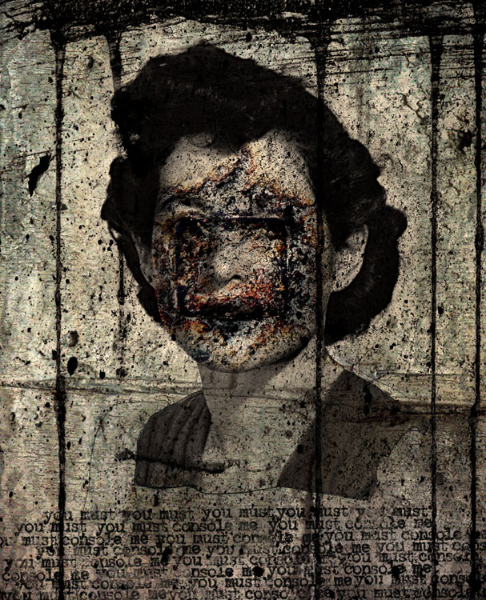 Frank Rodick, Portrait, Frances Rodick (you console me), 2012, archival pigment print, 100 x 81 cm. Courtesy of the artist and Articsók Gallery
Frank Rodick, Portrait, Frances Rodick (you console me), 2012, archival pigment print, 100 x 81 cm. Courtesy of the artist and Articsók Gallery
E.K-H: The other day we ran to each other at Starbucks and you mentioned that your work is currently on display at the Baltic Biennale of Photography in Kaliningrad and there is “trouble” around it. It touched a nerve of a politician who wants to remove your pieces, as he finds your depiction of your mother in that way “disrespectful”. I don’t think it has anything to do with your mother. It is a very expressive montage that addresses suffering. Death is one thing, suffering is another. Middle Europeans know suffering too well, its stages, the distortions it can make to their faces. People may relate to your works there in many different levels. There is a layered meaning in them, and a very strong one. I am sure people in Kaliningrad who go and see your photographs appreciate them more than you can imagine. Art is a political act there. Are you aware of the possibilities of different interpretations of your work? How do you feel about it?
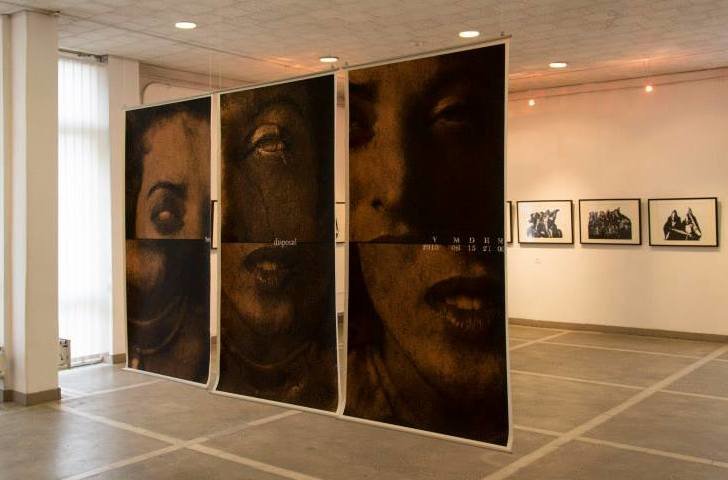 Frank Rodick, Portrait, Frances Rodick (from left to right: Sex, Disposal, Time), 2012, archival pigment print, each: 190 x 95 cm. Installation view from the Baltic Biennale of Photography in Kaliningrad, April 2015. Photo: Dmitry Kuryshev. Courtesy of the artist.
Frank Rodick, Portrait, Frances Rodick (from left to right: Sex, Disposal, Time), 2012, archival pigment print, each: 190 x 95 cm. Installation view from the Baltic Biennale of Photography in Kaliningrad, April 2015. Photo: Dmitry Kuryshev. Courtesy of the artist.
F.R: The problem in Kaliningrad has to do with politics and religion. Of course, I totally accept that there will be different interpretations of my work. Subjectivity’s inherent to the whole thing. I’ve always said that the longer view of the creative act winds up being a fusion between three elements: the artist, the artwork, and the audience that interprets the work. That fusion is dynamic, largely because of the changing audience, and the changing experience of the audience. No problem there at all. In fact, I can find it very exciting when I hear interpretations of my work that I didn’t expect. When I showed my early work, Liquid City, in Latin America, the Argentines would often interpret it in light of their own recent history. They’d talk about the similarities between the blurred, anonymous figures in Liquid City and their own tragic Desaparecidos, those people murdered anonymously en masse in Argentina’s Dirty War. Obviously, that wasn’t my intention in creating the work, but that doesn’t mean the interpretation wasn’t insightful, interesting, or ultimately valid. It was all of those things, and those people did me the generous honour of taking the time to place my work closely next to their own intimate experiences.
What I object to is careless, lazy, cynical, or pig-headed interpretation. That is, you have people who can barely be bothered to look, never mind think or feel, before they start talking about the work. Unfortunately, there’s nothing I can do about it.
I just make pictures. I make pictures to flesh out my personal obsessions and ruminations, to amuse myself, to have something to do that doesn’t bore me and doesn’t feel like a waste of time, to do something rather than nothing, sometimes to share something of myself with others, sometimes to scratch a nasty itch. What other people choose to do with the things I make isn’t up to me.
E.K-H: Your childhood, grotto like, images are very disturbing. They all pose a young boy’s body without limbs, mutilated (Everything Will Be Forgotten, self-portrait as child series). Why? Didn’t you have a happy childhood?
F.R: There were times I remember as happy. When a person suffers greatly, that suffering is often visited upon their children in some way. Perhaps not every single time, but usually – it depends a great deal on how the parent deals with their own suffering. And when there’s a background of historical trauma, this pain carries a cross-generational quality that can take generations to burn itself out.
I’ll tell you something I’m grateful for. Whatever the suffering I endured, I at least had some of the resources – whether they be external or internal – to try to make something out of that suffering that, I hope, isn’t destructive. My mother didn’t have the resources I had.
 Frank Rodick, Everything Will Be Forgotten, self-portrait as child, no. 1.2, (left) and no. 2.1 (right), 2014, archival pigment print, 100 x 70 cm. Courtesy of the artist and Articsók Gallery
Frank Rodick, Everything Will Be Forgotten, self-portrait as child, no. 1.2, (left) and no. 2.1 (right), 2014, archival pigment print, 100 x 70 cm. Courtesy of the artist and Articsók Gallery
E.K-H: There is so much pain and suffering in your photographs. As Nancy Brokaw said in her essay about your work, Sex, Death and Videotape, “I take one look and ask Do I really want these images lodged in my brain? Once you’ve crossed over into the mysteries of life and death, can you get a return ticket?” Why is your view so dark? How can you live with your images?
F.R: I don’t see my view as dark. It’s the world that’s dark. Not always, but when it is, and when it slams into you and yours, it’s transformative. I often think other people spend an awful lot of time and energy kidding themselves about the world, about other people, and about themselves. Sometimes I wonder how they live with that, especially when a crack in the carapace starts opening up. There are times when one gets a little more closely acquainted with reality’s cudgel and, after that, I’m sure the world’s never quite the same place. That’s the part where there’s no return ticket.
Mostly, I live with my images just fine — better than I live with the world around me if you really want to know. As for the pictures, here’s what I think and don’t think. I don’t think they’re the result of compromise, or other people’s opinions. They’re not hand-me-downs, pleas for acceptance, or chips in a game where I’m trying to get ahead. They’re not propped up with a wink and a smile. They feel like they’re mine. And in this world, how many things feel like they actually belong to you? There’s comfort there.
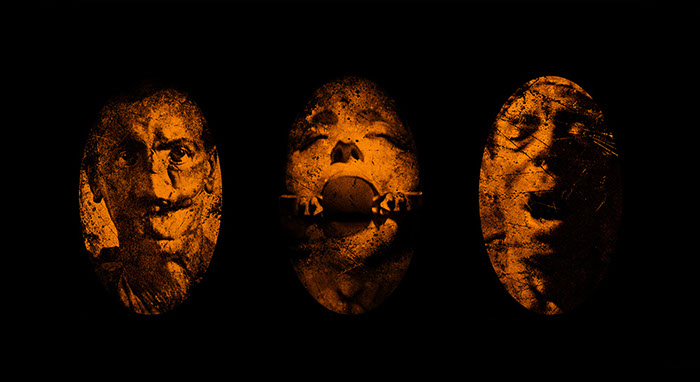 Frank Rodick, Three Studies for a Mouth (Explorations in statecraft, love, and the passing of woes), 2010, digital chromogenic print on metallic paper, 10.1 x 18.4 cm. Courtesy of the artist and Articsók Gallery
Frank Rodick, Three Studies for a Mouth (Explorations in statecraft, love, and the passing of woes), 2010, digital chromogenic print on metallic paper, 10.1 x 18.4 cm. Courtesy of the artist and Articsók Gallery
Emese Krunák-Hajagos
*Exhibition information: Everything Will Be Forgotten by Frank Rodick, April 30 – May 31, 2015, as part of Scotiabank Contact Photography Festival, Articsók Gallery, 1697 St. Clair Avenue West, Toronto. Gallery hours: Wed – Sat, 12 – 6 p.m.
*Note: A dialogue with Frank Rodick On sons and mothers, love, hate, and death… and why we make pictures even though Everything Will Be Forgotten is accompanying Frank Rodick’s show at Articsok Gallery on Thursday, May 7, 2015 / 7 p.m.

enjoyed looking at these images of your mother.I related it to my mom 95. and myself, 3rd time lung cancer . It affects my views and I liked your photo adjustments. maybe I can make your opening . Congratulations. barb mann